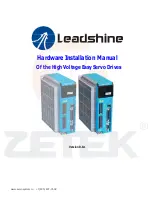
RD 500 RD51
Electrical Installation of Inverter
6-1
DOK-RD500*RD51*******-IB04-EN-P
6
Electrical Installation of Inverter
6.1
10 Rules for Installation of Drives According to EMC
The following 10 rules are the basics for designing drive systems in
compliance with EMC.
Rules 1 to 7 are generally valid. Rules 8 to 10 are especially important to
limit noise emission.
All metal parts of the switch cabinet should be connected with one
another through the largest possible surface area so that the best
electrical connection is established (no paint on paint!). If necessary, use
contact or scraper discs. The cabinet door should be connected to the
cabinet using the shortest possible grounding straps.
Signal, line supply, motor and power cables should be routed away from
another (this eliminates mutual interference!). The minimum clearance is
20 cm. Barriers should be provided between power and signal cables.
These barriers should be grounded at several locations.
Contactors, relays, solenoid valves, electromechanical operating hour
counters etc. in the cabinet must be provided with noise suppression
devices, e.g. using RC elements, diodes, varistors. These devices must
be connected directly at the coil.
Non-shielded cables belonging to the same circuit (feeder and return
cables) should be twisted with the smallest possible distance between
them. Cores which are not used must be grounded at both ends.
Generally, noise which is coupled in can be reduced by routing cables as
closely as possible to grounded sheet steel panels. For this reason,
cables and wires should not be routed freely in the cabinet, but as closely
as possible to the cabinet itself and the mounting panels. This is also true
for reserve cables.
Incremental encoders must be connected using shielded cables. The
shield must be connected at the incremental encoder and at the AC drive
converter through the largest possible surface area. The shield may not
be interrupted, e.g. using intermediate terminals.
The shields of signal cables must be connected to ground at both ends
through the largest possible surface area to establish a good electrical
connection (transmitter and receiver). If the potential bonding between the
screen connections is poor, an additional potential bonding conductor with
a cross-section of at least 10 mm² (AWG 6) should be connected in
parallel with the shield to reduce the shield current. The shields can be
connected to ground at several locations, e.g. on the cabinet housing and
on cable trays. Foil shields are not recommended. Braided screens
provide a better shielding effect (factor of 5).
If the potential bonding is poor, analog signal cables may only be
grounded to the converter at one end in order to prevent low-frequency
noise being radiated into the screen (50 Hz).
Always place a radio interference suppression filter close to the noise
source. The filter is to be connected flush with the cabinet housing,
mounting plate, etc. The best solution is a bare metal mounting panel
(e.g. stainless steel, galvanized steel), because the complete mounting
surface can be used to establish good electrical contact.
The incoming and outgoing cables of the radio interference suppression
filter should be separated.
Rule 1
Rule 2
Rule 3
Rule 4
Rule 5
Rule 6
Rule 7
Rule 8
Содержание RD 500 Series
Страница 32: ...2 12 Description of RD51 RD 500 RD51 DOK RD500 RD51 IB04 EN P...
Страница 174: ...5 34 Inverter Technical Data RD 500 RD51 DOK RD500 RD51 IB04 EN P...
Страница 248: ...9 4 Commissioning RD 500 RD51 DOK RD500 RD51 IB04 EN P...
Страница 274: ...14 6 Index RD 500 RD51 DOK RD500 RD51 IB04 EN P...
Страница 275: ......
















































